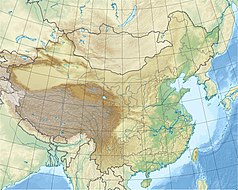Wutai Shan
| ||
| Obiekt z listy światowego dziedzictwa UNESCO | ||
 | ||
| Państwo | ||
| Typ | kulturowy | |
| Spełniane kryterium | II, III, IV, VI | |
| Numer ref. | 1279 | |
| Region[b] | Azja i Pacyfik | |
| Historia wpisania na listę | ||
| Wpisanie na listę | 2009 na 33. sesji | |
| ||
 | ||
| Państwo | ||
| Położenie | Xinzhou | |
| Wysokość | 3058 m n.p.m. | |
Wutai Shan (chiń. 五台山, pinyin: Wǔtái Shān = Góra Pięciu Tarasów) – góra w Chinach, w prowincji Shanxi, na obrzeżach miasteczka Taihuai (太坏, Tàihuài), o wysokości 3 058 m n.p.m. W tradycji chińskiej zaliczana jest do czterech świętych gór buddyzmu. Zachowały się tu kompleksy świątyń buddyjskich, w 2009 roku wpisane na listę światowego dziedzictwa UNESCO.
Góra ta stała się świętą górą, gdyż wierzono, że jest ona miejscem pobytu na ziemi Mandziuśriego (chiń. Wenshu 文殊). Szkoła huayan była związana właśnie z tą górą, a odpowiedni fragment[1] Sutry girlandowej pomógł uautentycznić obecność tego bodhisattwy na tej górze[2].
Pierwsze klasztory zostały wybudowane w IV i V wieku. W VI w. było ich już 200[3]. Mogły się one rozwijać dzięki poparciu przez dwór cesarski[4]. W klasztorach tych zapoczątkowano obchodzenie urodzin cesarskich i rocznice śmierci cesarzy jako wegetariańskiego święta, co został później przejęte przez inne klasztory w cesarstwie[5].
Największy rozkwit buddyzmu na tej górze przypadł na VIII i IX wiek. Do dziś przetrwało 58 klasztorów.
Do najważniejszych świątyń w rejonie góry Wutai zaliczają się:
- Tayuan si (塔院寺,Tǎyuàn sì) z wielką, białą pagodą w kształcie butelki, wznoszącą się na wysokości 56,4 m.
- Xiantong si (显通寺, Xiǎntōng sì) z siedmioma rzędami sal, które łącznie obejmują ponad 400 komnat.
- Nanshan si (南山寺, Nánshān sì) z okresu dynastii Yuan.
- Youguo si (佑国寺, Yòuguó sì) w pobliżu Nanshan si. Zachowały się tu freski, ilustrujące chińską powieść Wędrówka na Zachód Wu Cheng’ena.
- Shuxiang si (殊像寺, Shūxiàng sì) kryjąca 26-metrowy posąg Buddy wraz z rzeźbami pięciuset arhatów.
Galeria
Stupa na górze Wutai
Fresk z jaskini 61 Mogao w Dunhuangu przedstawiający klasztory na górze Wutai. X w.
Przypisy
- ↑ Mandziuśri pojawi się w północno-wschodnim kraju, gdzie będzie wygłaszał swoje nauki.
- ↑ Gregory 2002 ↓, s. 66.
- ↑ Fischer-Schreiber i in. 1989 ↓, s. 419.
- ↑ Ch'en 1973 ↓, s. 276.
- ↑ Ch'en 1973 ↓, s. 284.
Bibliografia
- Peter N. Gregory: Tsung Mi and the Sinification of Buddhism. Honolulu: University of Hawaii Press, 2002, seria: Studies in East Asian Buddhism. ISBN 0-8248-2623-X.
- Ingrid Fischer-Schreiber, Franz-Karl Ehrhard, Kurt Friedrichs, Michael S. Diener: The Encyclopedia of Eastern Philosophy and Religion. Boston: Shambhala, 1989. ISBN 0-87773-433-X.
- Kenneth Ch'en: Buddhism in China: A Historical Survey. Princeton: Princeton University Press, 1973. ISBN 0-691-00015-8.
- Simon Foster: Chiny. tł. Jarosław Fejdych. Bielsko-Biała: Wydawnictwo Pascal, 2001, s. 386-388, seria: Praktyczny Przewodnik. ISBN 83-88355-53-8.
Linki zewnętrzne
Media użyte na tej stronie
Autor: User:Doron, Licencja: CC-BY-SA-3.0
View of Taihuai with its temples and the stupa of Tayuan Si, at the heart of Wutai Shan, Shanxi province, China.
Autor: Uwe Dedering, Licencja: CC BY-SA 3.0
Location map of China.
EquiDistantConicProjection : Central parallel :
* N: 36.0° N
Central meridian :
* E: 104.0° E
Standard parallels :
* 1: 30.0° N * 2: 42.0° N
Latitudes on the central meridian :
* top: 57.0° N * center: 37.29° N * bottom: 17.96° NMade with Natural Earth. Free vector and raster map data @ naturalearthdata.com.
Autor: Angus Cepka, Licencja: CC-BY-SA-3.0
The Great White Pagoda of Tayuan Temple in Wutaishan, China. It was built in 1582 (as inscribed on a stone tablet there), during the Ming Dynasty.
Autor: Angus Cepka, Licencja: CC-BY-SA-3.0
The Grand Hall at the Yuanzhao Temple in Wutaishan, China
Black up-pointing triangle ▲, U+25B2 from Unicode-Block Geometric Shapes (25A0–25FF)
Autor: User:Doron, Licencja: CC-BY-SA-3.0
Stupa at the top of the Middle Peak of Wutai Shan, Shanxi province, China.
A mural painting from Cave 61 at the Mogao Caves, Dunhuang, Gansu province, China, dated to the 10th century and depicting Tang Dynasty monastic architecture from Mount Wutai (五臺山/五台山), Shanxi province.
Autor: David Wilmot, Licencja: CC BY-SA 2.0
The main Buddhist temple grounds at Mount Wutai, China.
Autor: Angus Cepka, Licencja: CC-BY-SA-3.0
Looking down over the Zunsheng Temple from the Manjusri Hall .
Autor: Angus Cepka, Licencja: CC-BY-SA-3.0
The Pagoda at the Lingfeng Temple in Wutaishan, China. The stupa is the oldest architecture in the temple. It is about 20 metres (66 ft) high and built of brick held together with clay mortar. The stupa was octagonal with five stories. The sumeru throne engraved patterns of Eight Heavenly Kings (Eight Diamond Kings). On the second floor, each side is carved with three Buddha statues. On the third floor, each side is carved with a Buddha statue. On the first floor, it is engraved with the words: "佛日圆照明古州和尚舍昨塔".
五台山-大文殊殿,殊像寺 由赵朴初题字
Autor: Baptiste Marcel, Licencja: CC-BY-SA-3.0
Information sur l'endroit d'où a été prise la photo : N39 19.363 E114 50.873. Les montagnes du Hébĕi (河北) et du Shānxī (山西) près de Láiyuán (涞源), vue vers le nord. Le massif au centre est le Wutai Shan (五台山), une des quatre montagnes sacrées bouddhiques de Chine qui culmine à 3 058 m au pic Yedou





















